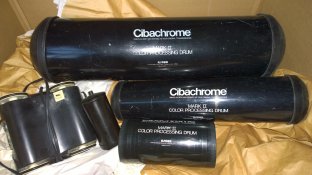Just a personal experience note on processing multiple smaller sizes in large drums.
I've used the 3063 drums on a Jobo CPP2 and could get very decent R-3 prints from it, using at least a quart of solutions.
I think I had to resort to processing at somewhat reduced developer temperatures for a longer time to get more even development and no streaks. I may have used a water pre-run/soak, not sure.
Now when I processed a batch (again R-3) of 6 identically exposed 8x10 prints in that same drum, I noticed slight color and density deviations in prints from lid to bottom, even across. For most pictorial prints that worked fine but for those that needed very critical color balance (e.g., almost monochromatic, snow scenes) the results were unacceptable to me. When you placed them side by side they were all a bit different.
That's when I started using a "split" Durst Printo machine for anything R-3 not exceeding 12" in one direction. Consistency was close to perfect with that method. "Split" refers here to a manual wash in the dark between 1st developer and re-exposure, before adding to the color developer tank. Bleaching and Fixing was usually done in heated trays, or another Printo section.
That said, depending on how accurate and even you want your film to be, gang-processing in a large drum may not live up to your standards.
The Jobo revolver chamber Expert tanks excel in evenness, even on a roller base without a water jacket. Sadly, they are scarce and the price is high.
Now one could fabricate something like them from 5 or 6 BTZS-type tubes bundled together...
Or process a bunch of smaller (BTZS-type) tubes in a tray with water. Or on your roller base. Perhaps tubes with large enough diameter for 2 8x10 sheets facing each other?






